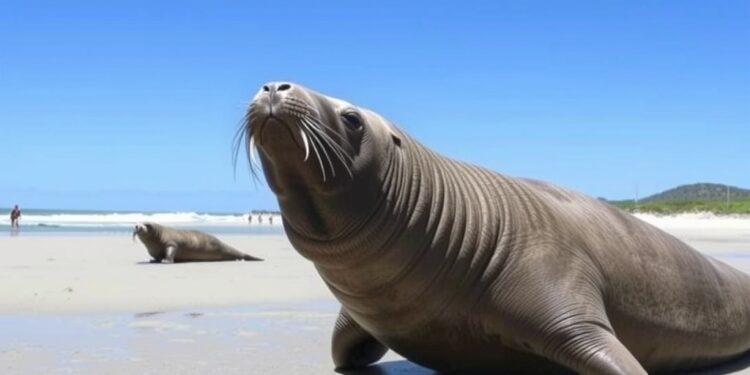Southern elephant seals, often referred to as the “canary in the coal mine” of the Southern Ocean, have become the focal point of new research investigating their historical and ecological significance in the context of climate change. Researchers are now uncovering their evolutionary journey and illustrating how these magnificent creatures serve as indicators of broader environmental shifts. The insights gained from these animals are critical, particularly as humanity grapples with the impending ramifications of climate change and its impact on marine ecosystems.
Historically, southern elephant seals thrived in large numbers across numerous coastlines, with their presence once felt across vast stretches of the Southern Ocean. They were not limited to the remote subantarctic islands and South America where they reside today. The acknowledgment that Aotearoa, or New Zealand, was once a thriving habitat for these colossal animals adds a riveting dimension to their survival narrative. Ecologists are now getting a clearer picture of the ecological dynamics in play before the significant shifts brought about by human activities and climate change.
The research highlights that, at the time of human arrival in New Zealand, nature would have presented an awe-inspiring scene filled with diverse marine life. Our beaches would have been crowded with elephant seals, fur seals, prehistoric sea lions in full grandeur, and a multitude of penguins. This historical abundance is often unfathomable for contemporary observers. The presence of such majestic giants in New Zealand’s past fundamentally challenges our understanding of the region’s biological heritage.
Scientists from various international institutions collaborated on this groundbreaking study, spearheaded by postgraduate students Andrew Berg from the University of Sydney and Megan Askew from Otago University. Their groundbreaking work culminated in a publication in the distinguished journal Global Change Biology, where their findings are poised to reshape our understanding of elephant seals and their historical ranges. They employed cutting-edge palaeogenetic techniques, delving into specimens that date back thousands of years from New Zealand, Tasmania, and Antarctica.
Through their research, the team revealed that southern elephant seals were once widely distributed across the Southern Ocean. Their findings suggest that a combination of glacial activity, induced by Ice Ages, and the pressures of indigenous hunting and European industrial sealing drastically altered their habitats. The seals’ evolutionary journey is a testament to their resilience, yet it is also a narrative of decline brought forth by human influence.
Dr. Mark de Bruyn, a co-author of the study from Griffith University, emphasized the significant effects of climate change on elephant seals. The dramatic increase of sea ice surrounding Antarctica prompted these seals to retreat to several refugia across continents, including South Africa, Australia, New Zealand, and South America. Increasingly, as glacial periods gave way to warmer climatic conditions, these seals expanded their range, even temporarily populating the Antarctic mainland.
However, the seal population faced another setback, resulting in a narrower distribution caused by human actions. Indigenous subsistence hunting, alongside rampant industrial sealing during European colonization, led to substantial contractions in their range. These activities stripped them from many of their former habitats, confining them to the deep Southern Ocean, effectively erasing their presence from areas like Australia and New Zealand.
The current findings vastly improve our understanding of how southern elephant seals have historically responded to environmental changes. Associate Professor Nic Rawlence, the study’s joint senior author, asserts that examining the past responses of elephant seals to climate fluctuations can furnish vital insights into their future adaptability amid unyielding human-induced alterations in marine ecosystems. In doing so, we can prepare for the potential impacts that may arise from ongoing climate change.
With such a dynamic evolutionary history at play, it becomes inevitable to conclude that without significant concerted efforts to mitigate human-driven climate change and to protect vital marine ecosystems, elephant seals, along with other marine species, are bracing for turbulent challenges in the years to come. Our responsibility lies not only in understanding these magnificent creatures but also in safeguarding their existence amidst a rapidly changing planet.
In summary, the southern elephant seal story serves as a poignant reminder of the complexity of marine life and how intricately balanced ecosystems can shift under both natural and anthropogenic pressures. It spotlights the need for increased awareness and action as we navigate the challenges posed by climate change. As we stand on the brink of the climate crisis, the lessons learned from the elephant seals’ past may very well inform our future, reinforcing the urgency needed to reverse the course of environmental degradation and preserve our planet’s biodiversity.
Moreover, this research invites a broader conversation about the interconnectedness of species and ecosystems. The fate of the southern elephant seal is emblematic of the struggles many species face today. It urges the scientific community, policymakers, and the public alike to confront these challenges with renewed vigor, embracing sustainability and advocate for proactive measures that can secure a healthier marine environment for both present and future generations.
Subject of Research: Animals
Article Title: Postglacial Recolonization of the Southern Ocean by Elephant Seals Occurred From Multiple Glacial Refugia
News Publication Date: 7-Mar-2025
Web References: http://dx.doi.org/10.1111/gcb.70101
References: Global Change Biology
Image Credits: [Image Credit Not Provided]
Keywords: Marine ecosystems




